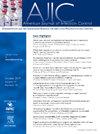Targeting prolonged short-term central venous catheters to reduce hospital-wide catheter days and CLABSI rates
IF 3.8
3区 医学
Q2 INFECTIOUS DISEASES
引用次数: 0
Abstract
Background
The risk of central line-associated bloodstream infection (CLABSI) is associated with central venous catheter (CVC) dwelling time. We implemented a hospital-wide intervention aimed to alert physicians to CVC duration and necessity and to improve the monitoring of CLABSI prevention process measures outside the intensive care unit (ICU).
Methods
A retrospective, before-after study that evaluated short-term, nonhemodialysis CVCs in and out of the ICU. The intervention included enhanced bundle-prevention measures monitoring and staff “sensitization” regarding prolonged (> 7 days) CVCs (pCVCs). The ICU intervention also included daily CVC-stewardship visits. We assessed CVC utilizations and CLABSI episodes 20 months before to 19 months after the intervention using Mann-Whitney tests.
Results
Out of the ICU, CVC-utilization ratio (CVC-UR) and pCVC-UR reduced significantly (4.1-2.7/100 hospital days, P = .005; and 28%-21%, P = .02, respectively). Bundle-prevention measures improved, and CLABSI rates reduced postintervention (7.9-3.6/1,000 CVC days, P = .03). In the ICU, pCVC-UR reduced significantly (29%-15%, P < .0001). Baseline ICU-CLABSI rates were low and did not reduce postintervention.
Conclusions
Sensitizing physicians to the existence and duration of CVCs accompanied by improved bundle-prevention measures, resulted in reduction of pCVCs, and outside the ICU, also in reduction of CVC-UR and CLABSI rates.
针对长期短期中心静脉导管,减少全院导管使用天数和 CLABSI 感染率。
背景:中心静脉导管相关血流感染(CLABSI)的风险与中心静脉导管(CVC)的留置时间有关。我们在全院范围内实施了一项干预措施,旨在提醒医生注意 CVC 的持续时间和必要性,并改善重症监护室(ICU)外对 CLABSI 预防流程措施的监控:一项回顾性、前后对比研究,评估了重症监护室内外的短期非血液透析CVC。干预措施包括加强捆绑式预防措施的监测和工作人员对长期(>7 天)CVC(pCVC)的 "敏感性"。重症监护室的干预措施还包括每日CVC巡视。我们使用 Mann-Whitney 检验法评估了干预前 20 个月至干预后 19 个月的 CVC 使用情况和 CLABSI 发病情况:在重症监护室外,CVC-使用率(CVC-UR)和pCVC-UR显著降低(分别从4.1降至2.7/100 HD,p=0.005;从28%降至21%,p=0.02)。干预后,捆绑预防措施有所改善,CLABSI 感染率也有所下降(每千个 CVC 日从 7.9 降至 3.6,p=0.03)。在重症监护室,pCVC-UR 显著降低(29% 降至 15%,P=0.03):让医生意识到 CVC 的存在和持续时间,同时改进捆绑预防措施,可减少 pCVC,在重症监护室外,还可降低 CVC-UR 和 CLABSI 感染率。
本文章由计算机程序翻译,如有差异,请以英文原文为准。
求助全文
约1分钟内获得全文
求助全文
来源期刊
CiteScore
7.40
自引率
4.10%
发文量
479
审稿时长
24 days
期刊介绍:
AJIC covers key topics and issues in infection control and epidemiology. Infection control professionals, including physicians, nurses, and epidemiologists, rely on AJIC for peer-reviewed articles covering clinical topics as well as original research. As the official publication of the Association for Professionals in Infection Control and Epidemiology (APIC)

 求助内容:
求助内容: 应助结果提醒方式:
应助结果提醒方式:


